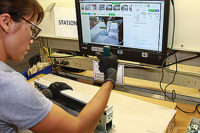Imagine a world without dependable global navigation satellite systems (GNSS). Air and sea transportation would stop, and militaries would be blinded. NovAtel Inc. is committed to preventing this scenario.
For more than 20 years, the Calgary, Canada, company has manufactured high-quality GNSS components and subsystems for customers in the United States, Europe, Japan, China and India. Its products include antennas, receivers, enclosures and firmware—all of which offer reliability, low power consumption and comprehensive message suites for configuration and data logging.
For many years, NovAtel assemblers relied on hard-copy work instructions created in Word. Unfortunately, updating the documents was time consuming,
and assemblers often had trouble spotting text changes within the latest version.
Dennis Ho, manufacturing manager for NovAtel, realized that time spent on non-value added tasks, such as formatting and organizing information, was hurting productivity and contrary to the company’s lean manufacturing initiative. So in 2007, the facility installed Sequence Enterprise software from FFD Inc. on one production line to see how assemblers would fare with paperless instructions.
The software offers real-time change control and a direct link for operator feedback to the responsible manufacturing engineer. It also captures multimedia (audio, video, CAD) to quicken an assembler’s learning curve.
“In the past, [making] the simplest change could take 1.5 hours, and we had to print out the document,” says Ho. “Today, it takes five minutes, and every workstation has a terminal [so the assembler] goes online and always has the latest version.”
Within Sequence, each assembly is associated with a set of instructions, a bill of materials, assembly tools, references, calibration procedures and best practices. Ho says these resources enable NovAtel managers to immediately locate and correct problems on the assembly line so they don’t negatively impact production or quality.
The software allows each assembler to request his instruction changes—and continuously track those of other assemblers—without leaving the workstation. Previously, an assembler had to enter each change into a spreadsheet and pass it to the next assembler on the line. Ho says this method often took so long that operators became frustrated and stopped doing it.
Engineers review all requested changes on a weekly basis. Every approved change is automatically updated in the software and the plant’s material requirements planning system.
“New instructions are approved by engineering far in advance to ensure that we properly translate them onto the shop floor,” notes Ho. “The software helps [us] deliver high-quality, standardized products on time with very low defect rates.”
Ho also says it is easier to train assemblers with Sequence software than hard-copy drawings and Word files. The software’s many benefits led NovAtel to install it on a second production line in 2012.
For more information on paperless work instructions, call 866-863-7541 or visit www.sequencesoftware.com.







